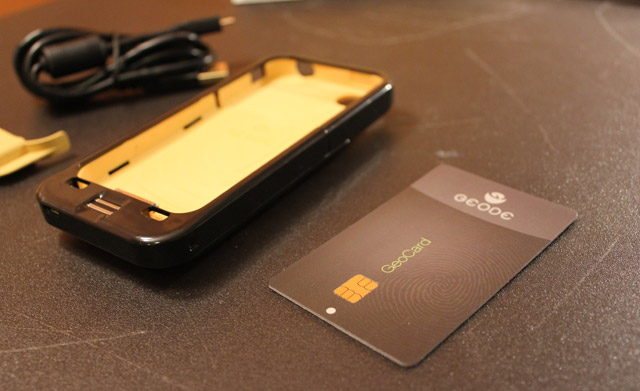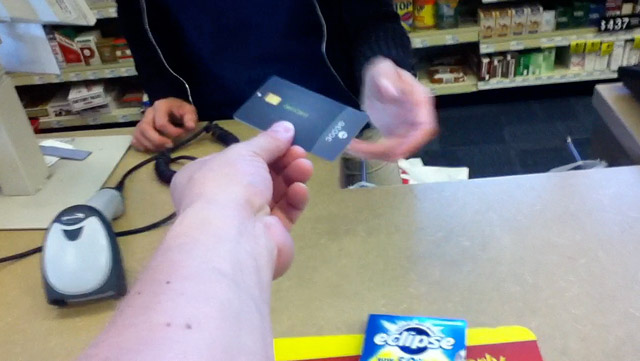I have to admit, when I first heard about the Kickstarter project for the iCache Geode Mobile Wallet I thought to myself “yeah right…good luck with that.” The process seemed unlikely to me.
First of all, how are the card networks ever going to let someone temporarily “clone” their cards onto another dynamic card? Secondly, how fast could the process work? There could be a lot of challenges.
I was able to get my hands on a newly shipped unit and put it to the test. I captured the results in the video below. Does it work? Yes, it actually completes payments at places that accept it. There is definitely a learning curve to use it successfully, but after I figured out the total procedure and practiced it a few times, the Geode and it’s little GeoCard actually let me buy some things.
It’s pretty well documented at this point, but if you don’t know what the iCache Geode is, it is an attempt to convert the iPhone into an all-in-one digital wallet for your credit cards and loyalty cards.
Essentially, it is an iPhone sleeve outfitted with a fingerprint reader (for authentication), an E Ink display on the back for loyalty card barcodes and a single, dynamic credit card that can be temporarily and securely encoded with any of the credit cards you upload into the app. (It also comes with a detachable magstripe reader that you use to swipe and upload your cards into the secure element in the sleeve — a nice touch).
In this way, you can carry a single plastic credit card that can act as any of your credit cards, whenever you need them. This sleeve/case works seamlessly with an iOS app that manages all your payment and loyalty cards.
A Few Caveats
Does it work everywhere? Unfortunately, not everywhere I tried could accept the card. The two self-service gas stations where I attempted to use it would not accept it. During a quick call with the makers, iCache Chief Strategy Officer Erik Ross explained that there is a known issue with dip-style credit card readers (the kind you insert and pull out manually) and that they are working on getting the GeoCard to work with them.
Another thing is that you have to remember to “flick” the card with your fingers to activate it after you have loaded it with your card info but before swiping it. It’s kind of a hassle, but it’s not for arbitrary reasons and rather is how the battery life in the card is conserved — it’s not activated until flicked. According to iCache, a new version of the GeoCard will be coming soon that is rechargeable.
As for how the big card networks allow this dynamic card to be used on their networks…I’m not completely sure. But apparently iCache is being treated like any other issuer and as long as the card meets size, security and operational rules (which it must be doing), it sounds like it is good to go.
I inquired with iCache about this and they told me that GeoCard transactions look like any other payment card transactions during processing and that the card meets CAST standards (Compliance Assessment and Security Testing).
The Bottom Line
I really like the Geode and would continue to use it myself, but I’m not sure I would leave all my credit cards at home just yet. It’s not a 100% bullet proof solution for payments in my estimation. I mean, regular credit cards get declined from time to time too. But the Geode was 3 for 6 in my attempts (3 out of 4 in the video and 0 out of 2 at gas stations). That’s 50% effective in my little field test and not enough to instill confidence to carry it alone.
I realize that this defeats the purpose of having a mobile wallet — it has to work as well and often as your regular wallet or you are just inefficiently carrying around two wallets — but what can I say…as a payments nerd, I just think the Geode is cool.
The other challenge the Geode will face is one of perception. Any problem with a purchase at all — even a delay of a few seconds or holding up a line while you are fooling around with a newfangled card — can cause a sort of stigma for the purchaser. I felt it myself as I attempted to use the card at one of the locations but had to reboot the app to get the fingerprint scanner to log me in.
Any weirdness or problem with any credit card draws attention to the user that could be interpreted by others as “uh, oh…this guy doesn’t have enough money in his account”. It could be embarassing and lead people to question attempting use the next time.
Also, the case is kind of large.
BUT…
I am pretty forgiving when it comes to products that are sincerely trying to innovate and this thing is clever. Assuming the company maintains the product, the GeoCard will be accepted at more and more places. And despite some launch limitations I want to emphasize that I still think the Geode is a great idea and a real business opportunity for iCache.
Particularly on the loyalty card front, the Geode E Ink display solves some real problems caused by the current limitations of existing mobile hardware (namely the ability for digitized loyalty cards to be scanned by legacy, laser scanners).
I think one also has to remember that the Geode is attempting to change some features of an entrenched payment system and that is no small feat. In the USA, the credit card industry has remained mostly unchanged for 20 years and building a multi-use dynamic card definitely colors outside the lines.
These attempted changes — the same things that could cause some short term bumps in user experience — are what uniquely identify this product. It’s possible that they could reach enough scale to offer the hardware for free or reduced prices — remember that the $160 price tag on this version was tied to Kickstarter project for development.
But the biggest thing to think about, from a business standpoint, is that the Geode is really solving two problems. With it, iCache are attempting to offer a solution that works for the current payments paradigm (based on physical cards), but at the same time they have a powerful mobile wallet app that poises them to remain a player when the existing payments infrastructure evolves enough to allow ubiquitous digital/mobile payments. There will be a lot of competition in that swiftly approaching mobile wallet space (another issue altogether), but getting into it now could help them remain viable in the future…or become an acquisition target.
My prediction is that, as secure elements begin to be offered in more and more mobile devices, iCache will shed their own hardware and their wallet app will be able to work directly with phone hardware, instead of with external cases. Or perhaps they’ll shed the secure element scenrio altogether and offer a purely cloud-based solution. In any event, their business model seems to have its eye on current and future states of the payments space and that’s a smart approach.

